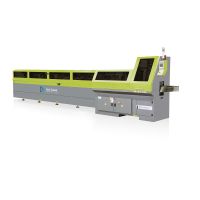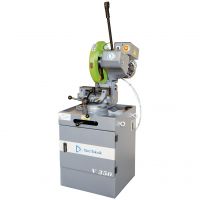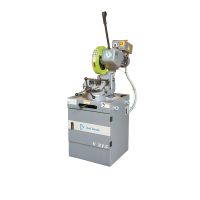Why are my coldsaw blades breaking?
The term ‘coldsaw blade’ is often applied to more than one type of circular saw blade. This article refers to coldsaw blades as those which are entirely manufactured from a single piece of solid high speed steel (no carbide tips) which are used for metal cutting on purpose-built slow revolving machinery.
There are a number of reasons for tooth loss and outright blade breakage in metal cutting coldsaw blades, so in this article we’ll detail the main ones we come across. Briefly summarised, these are:
- Machine gearbox wear
- Incorrect tooth pitch
- Incorrect sharpening
- Blunt blades
- Material pickup on the side of the blade
- Angle cutting on round material
- Insufficient material clamping
- Blade run-in procedure
- Feed rates
- Blade material type
Machine Gearbox Wear
Excessive ‘backlash’ in a coldsaw gearbox can lead to a shock to the blade as the teeth engage the cut, and higher than normal cutting vibration. Both these things can lead to tooth loss, and if the operator continues to cut with the blade in this state it can lead to complete blade failure.
To check how much backlash your machine gearbox has, simply rotate the coldsaw back & forth by hand – ideally, you should only be able to get about 1mm of movement out of it.
If you think excess backlash could be a factor in breaking your coldsaw blades and you don’t want to replace the machine or gearbox, a solution which sometimes helps is to go to a thicker blade. i.e. if you run a 350 x 2.5mm blade, try going to a 350 x 3.0.
Incorrect Tooth Pitch (distance between teeth)
Too few teeth in a cut can cause a tooth to snag on the workpiece and rip out teeth. Conversely, too many teeth in a cut can cause chip packing in the gullets, as the chips cannot escape until they reach the other side of the cut – and this on its own can cause teeth to rip off, and the problem can also be exacerbated by an exasperated operator who pulls ever harder on the handle in response to the slow cutting rate!
Speak to your blade supplier or sawdoctor about the correct tooth pitch for the material sizes you’re cutting, and bear in mind that as blades are sharpened and decrease in diameter, the tooth pitch also decreases. Sometimes, blades need to be ‘recut’ to reset the tooth pitch to what it was originally.
Incorrect Sharpening
The optimum height of a coldsaw blade tooth is quite critical, and as a rule of thumb should be approximately 45% of the tooth pitch. A short tooth may seem like a strong tooth – and it is – but this can also mean the size of the gullet is smaller than it needs to be to accommodate the chips, leading to chip packing and potential blade failure. Too high or too thin a tooth leaves it weak and vulnerable to breaking off.
The bottoms of the tooth gullets must be curved the whole way from the top of one tooth point to the next without any ‘corners’ in the shape of the grind. If there are any tight corners in the tooth gullet these will be vulnerable to cracking.
Blunt blades
The main risk of breakage arising from a blunt blade is a frustrated operator! As mentioned earlier in the article, if the operator has to haul on the handle – or in one case we saw, tie a load binder to the handle with a loop formed for operators to stand in – then you are probably overdue for a blade sharpen.
Material pickup on the side of the blade
Material pickup on the side of the blade is a phenomenon which is generally caused by cutting certain materials such as larger stainless sections, aluminium and galvanised material. Incorrect tooth pitch and coolant ratios can exacerbate the problem, while certain blade coatings can alleviate it. Whatever the cause, if you have this pickup on the side of the blade and continue cutting, it tends to put a shock through the blade each time the affected area contacts the cut material. Sometimes this shock is enough to crack and break a blade.
Some operators do achieve a degree of success using an extremely fine honing stone to remove the pickup, but usually once an area of a blade has had the problem, it will continue to pickup unless the blade diameter is reduced to below the problem area.
Angle cutting on round material
In most machines which have a single-action vice, i.e. only the front part of the vice moves, the attack point of the blade as it strikes the material will vary according to the size of the material being cut – sometimes it may the top of the material, sometimes it may be more on the side. This doesn’t usually have a lot of consequence for straight cuts, but can be problematic when attempting to cut angles, especially on round materials.
When cutting angles, if the blade’s first touch point is the highest part of the round, no problem. But the further away from the top of the round the blade first makes contact, the more it will start the cut on just one corner of the blade, instead of touching square-on across the full width of the tooth.
The problem with this happening is that the blade deflects slightly from the pressure on one side, and high speed steel does not take kindly to someone trying to bend it! It has very little give and may unceremoniously snap, sometimes a good way through the cut.
Solutions include packing out the material from the back of the vice so the blade strikes the top of the material, to entering the first part of the cut slowly to minimize the potential deflection, to using a thicker blade which is less likely to deflect.
Insufficient material clamping
Very little needs to be said on this topic, but if your material is able to move while cutting, expect blade breakage! This can be because of a worn-out vice, but also happens when bundle cutting rounds.
Blade run-in procedure
With coldsaws, we say there are two times in a blade’s sharpen life which it is the most vulnerable; when it is so blunt that operators tend to haul on the machine to force an unwilling blade through the workpiece; the other instance being when it is newly sharpened (or brand new). Like many other cutting tools, a newly sharpened coldsaw blade can and should be razor sharp, but this can make it prone to biting into material and ripping out teeth in the process.
Be aware of this tendency, and for the first few cuts feed the blade through the material with added care, including reducing the feed rate to perhaps 50% of normal. Once that super-sharp edge has been effectively honed off, you may proceed to cut at a normal pace.
Feed rates
Unfortunately, your coldsaw is not a rotary axe! Each tooth has a certain capacity to remove material which is governed by the material characteristics such as type, size & hardness, and by the characteristics of the blade itself such as tooth pitch, attack angle, available space in the gullet for spoil etc. If pushed beyond that capacity too far then something has to give which is most often the teeth - the weakest part of the blade.
If using a manually fed machine, light to moderate pressure on the handle should be all that is needed to form ideal chips, which are short curls of material shaped like 6’s & 9’s in the case of long chip materials such as mild steel. If you find yourself having to apply more pressure than that, something is wrong! A blunt blade, incorrect tooth pitch or tooth angle, incorrect blade type or too hard a material are all things which may need correcting to avoid a costly breakage.
Blade material type
The most common material used in coldsaw blade manufacture is DM05. This is a good all-round cutting tool material well suited to use on manual machinery cutting mild & medium tensile steels, non-ferrous materials, and with care, most stainless steels. It is at the softer end of the coldsaw blade hardness scale, but this fact also means it is less brittle than its higher end cousin, HSS-Co-5% which includes a 5% cobalt content. Less brittle equals greater resilience to the sort of shock which tends to be more prevalent in manually fed situations.
Conversely, if you have automatic feed or a very careful operator, along with an accurate & maintained machine, a cobalt HSS blade might be worth your while trying for longer life between sharpens – especially on difficult materials.
If you need more specific or direct help with a breakage problem, please don’t hesitate to reach out to one of the team at customercare@wolfmach.com



